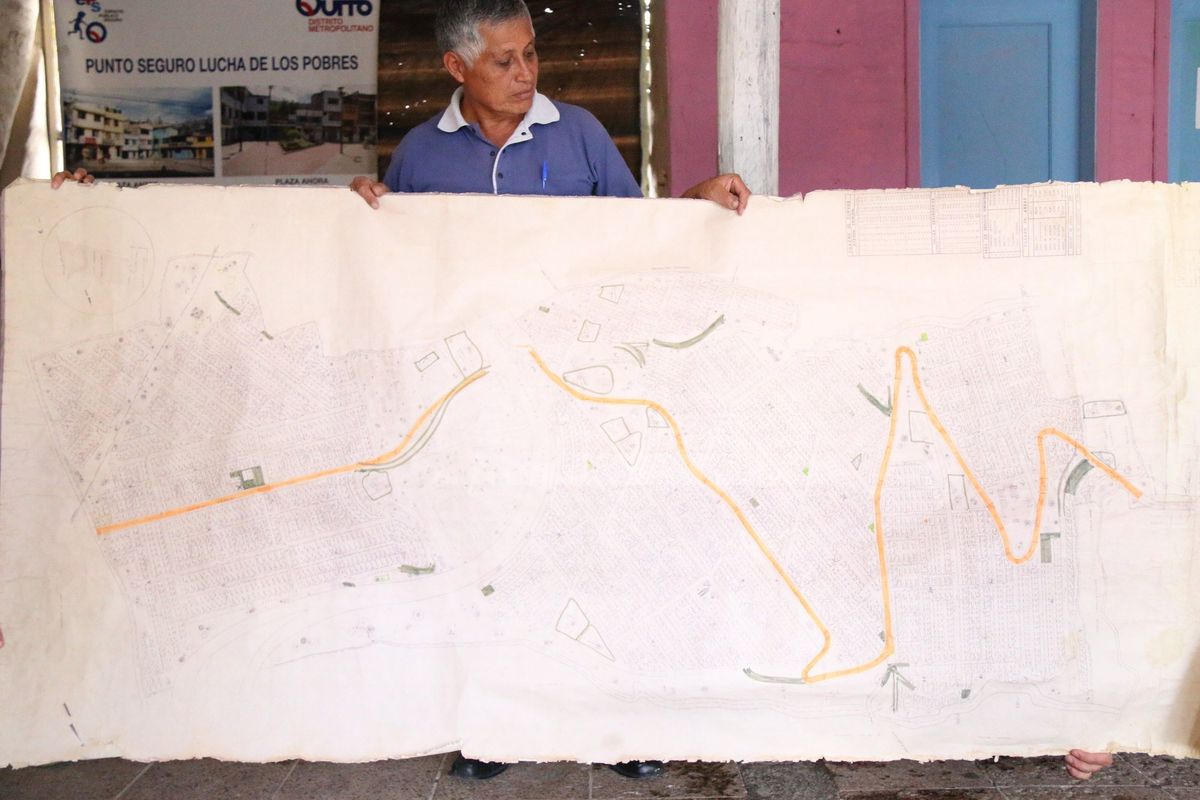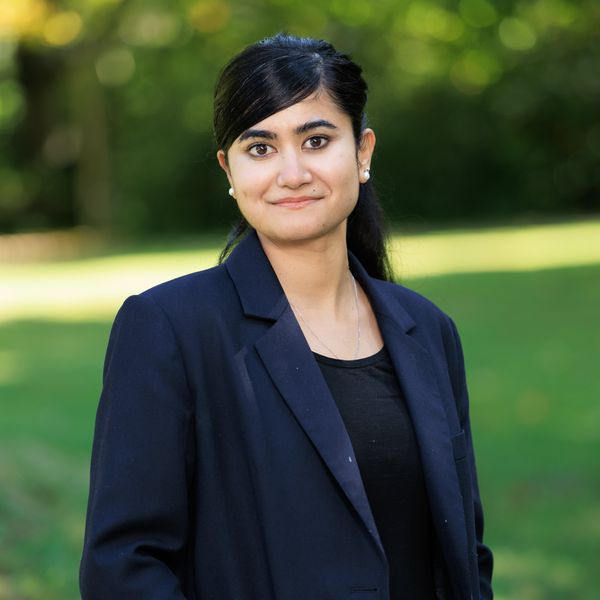
As my plane banked and headed toward the international airport in Mumbai, a staggering scene unfolded before me through my small oval window.
A sea of blue-tarp-covered shacks extended to the airport boundary, as if the fragile airport wall was holding back a tsunami of nearby informal settlements. The ubiquitous blue waterproof tarp, a symbol of the city, serves as the primary protection against – and poignant reminder of – the harsh annual monsoon season, underscoring the inequities in the city.
This essay is also available in Spanish and Hindi
From this bird’s eye perspective to ground level, a more nuanced reality came into view. As an urban planner living and working in Mumbai, I saw how, contrary to popular media representations, not all homes in informal settlements resembled the shacks I first witnessed on the outskirts of the airport. Within the same neighborhood, housing can range from flimsy shelters made of low-cost materials to multistoried brick and cement structures, often part of informal rental markets.
The ‘favelas’ of Brazil, ‘bastis’ of India, ‘katchi abadis’ of Pakistan, ‘kampungs’ of Malaysia and the ‘barrios’ and ‘comunas’ of Venezuela and Colombia — these neighborhoods are as diverse as the names used to describe them. Despite their differences, informal settlements often face similar struggles. From poor air quality and inadequate housing conditions to limited access to water, sanitation and electricity, informal neighborhoods face environmental and social challenges that harm people’s health, affecting the poorest and most marginalized communities the hardest. Given that more than one billion people in the Global South – a quarter of the world’s urban population – live in informal settlements, this is no small issue.
As an urban planner and environmental health researcher, I am convinced that place-based approaches that take into account the physical complexities and community relationships of informal neighborhoods are essential to developing solutions that improve the wellbeing of residents while addressing the stigma associated with living in them. Unlike conventional approaches that rely on global “best practices” or impose top-down policies that neglect local context, community-led strategies involve active engagement with residents, seeking to improve the physical conditions of settlements while strengthening existing community ties.
The health hazards and stigma of informal settlements

The United Nations defines a ‘slum household’ (a term that might marginalize and homogenize the experiences of local communities) as a place where residents have limited access to clean water, lack sanitation, live in overcrowded and poorly-built constructions, suffer from an insecure housing tenure, or all of the above. Although I am using “informal settlements” as a synonym for “slums” here, I am aware of the continued debate surrounding these names as well as the usefulness of the “slum” label, which provides legal recognition to informal neighborhoods in certain countries, including in India. The urban research collective Urbz has coined “homegrown neighborhoods”, a name which gives agency to communities by emphasizing the labor and local expertise of residents that gave rise to these diverse places.
Often located in low-lying, flood-prone areas, hilly regions or near polluting facilities and landfills, informal settlements are disproportionately exposed to environmental pollution and health risks from natural disasters. Since cities do not legally recognize most settlements, they frequently do not have good access to water, sanitation and electricity, which creates a breeding ground for water-borne diseases like cholera, hepatitis, bacterial infections from poor personal hygiene and health risks from heat stress. And many informal settlements are also overcrowded, making them susceptible to the spread of both infectious diseases from contagion and noninfectious diseases from poor living conditions. Lack of resources and services like public transportation, schools or healthcare centers limits opportunities for residents. Despite these risks, policymakers and government welfare institutions turn a blind eye due to existing prejudice and the precarious legal status of these communities, deepening poverty and health hazards.
These inequalities became more salient to me when I worked with communities in Shivaji Nagar, one of Mumbai’s poorest and most underdeveloped informal neighborhoods. Shivaji Nagar borders one of the largest landfills in India, resulting in serious environmental health risks and air quality problems. It is overcrowded with approximately 600,000 people in about a half a square mile (a densely-populated city like New York, in contrast, has approximately 28,000 people living in one square mile). Access to clean water and sanitation is limited with only one toilet for every 145 people. More than a third of households have a monthly income of $100 or less, many of which belong to marginalized Muslim and Dalit (lower-caste) communities.
Recognizing existing community structures

While I use the term informal settlement, working with communities I realized that there are formal systems of community and spatial organization within these places. During a workshop that brought community members, academics and architects together to design and test small-scale interventions for improving Shivaji Nagar’s street furniture (such as public benches or street lights), garbage disposal, water access and community gardens, it was evident that the neighborhood has its own “formalized” systems of organization. These systems manifest in various ways, from the gridded and numbered streets — a visual reminder of the neighborhood’s history as a government-planned resettlement colony — to the community groups and religious organizations that coordinate local worker groups, manage community gardens and public places, and provide financial and social support during times of need. Such self-organized community initiatives are characteristic of the informal, helping underserved communities improve their quality of life through self-determination.

As I conducted research in other countries, getting to know people living in informal settlements, I realized that the few successful solutions for these places center communities and respect the existing networks and systems of organization. An example is Lucha de Los Pobres (‘The Fight of the Poor’), an informal settlement that was transformed into a thriving neighborhood of Quito, the capital of Ecuador.
While filming a documentary about the inception of this neighborhood, I interviewed Rodrigo Gualotuña, a community leader, who told me the story of his community. In 1964, Ecuador’s Agrarian Reform Law abolished Indigenous forced labor and this, coupled with the petroleum boom, led to mass migration to Quito. Due to a lack of affordable housing and discriminatory land ownership practices, migrants were forced to seek alternative forms of shelter. This neighborhood came about through an organized occupation of a hacienda (estate) in southwestern Quito, where thousands of Indigenous community members self-organized and occupied underutilized land overnight and built homes. It was a haven for low-income families who lacked shelter through conventional means. With years of protest and negotiation, Lucha de Los Pobres was recognized by the Municipality of Quito and provided with basic infrastructure and social services. This story illustrates a community-led approach that relied on the self-determination and resilience of the residents, many of whom have worked to build and incrementally expand their homes from simple single story constructions to impressive multi-story structures.

This incremental housing approach – where residents build and expand their homes over time – presents an affordable solution to the housing needs of low-income populations. As part of a study led by MIT’s Special Interest Group for Urban Settlements, I organized interviews with residents and workshops with children from the community to ask them how they felt about their neighborhood. Their responses confirmed that the many in the community had a sense of pride about incrementally building their own homes and public spaces to meet their needs, developing building and construction expertise and deepening community bonds in the process.
Upgrade, not uproot

So how can we improve people’s health and wellbeing in informal settlements? For policymakers and researchers, this means listening to communities that live there. It means including communities in all research efforts. It means understanding what is already working, elevating effective, homegrown solutions wherever possible, and integrating these into formal municipal governance. It means acknowledging that there is no one-size-fits-all answer and what works for one neighborhood may not work for another. It means building strong partnerships between communities and local governments to co-create and implement place-based policies and programs that upgrade neighborhoods where they are, instead of uprooting and forcibly evicting them.
By the middle of this century, up to three billion people are estimated to live in informal settlements, yet these places remain largely invisible to policymakers and neglected in policy decisions. There is a lack of data about the environmental factors, demographics, disease and health statistics for these neighborhoods, which limits our ability to understand public health challenges and focus resources on community health needs.
Informal settlements are complex and our efforts to understand them should reflect this complexity. Place-based research and policy will shed light on this intricacy and generate innovative solutions to physical infrastructure and legal representation, working hand-in-hand with communities.
Informal settlements are not a monolith. From Shivaji Nagar in Mumbai to Lucha de Los Pobres in Quito, they each have unique histories, contexts, challenges and people who have built the places that they call home.

Sabah Usmani is a Ph.D. student in the Climate and Health Program at Columbia University’s Mailman School of Public Health. Sabah has a master ‘s in City Planning from Massachusetts Institute of Technology and a bachelors in Civil Engineering (minor in architecture) from Columbia University.
This essay was produced through the Agents of Change in Environmental Justice fellowship. Agents of Change empowers emerging leaders from historically excluded backgrounds in science and academia to reimagine solutions for a just and healthy planet.




